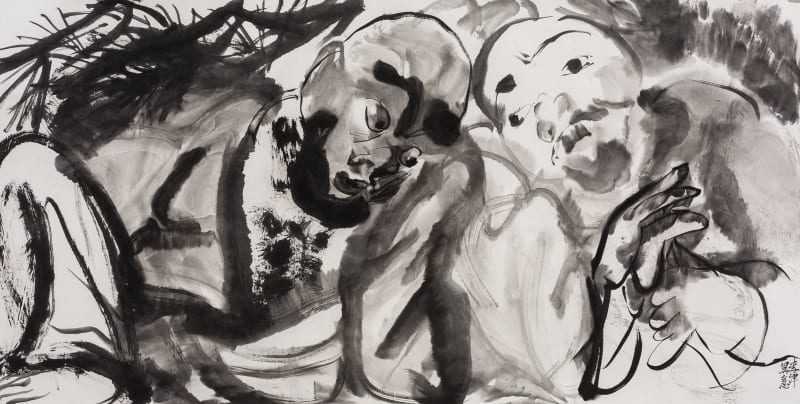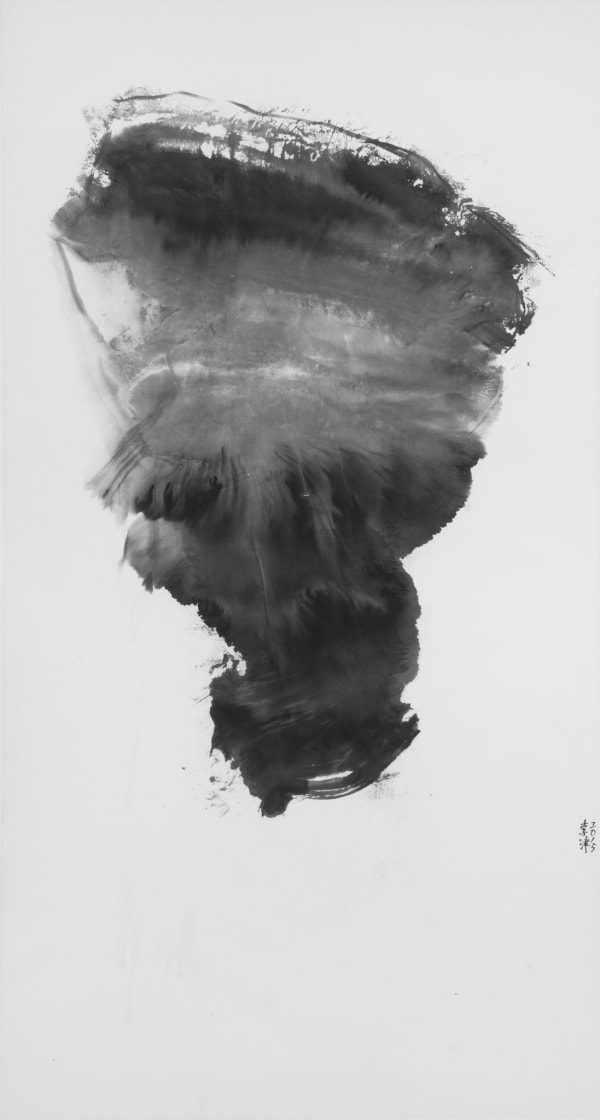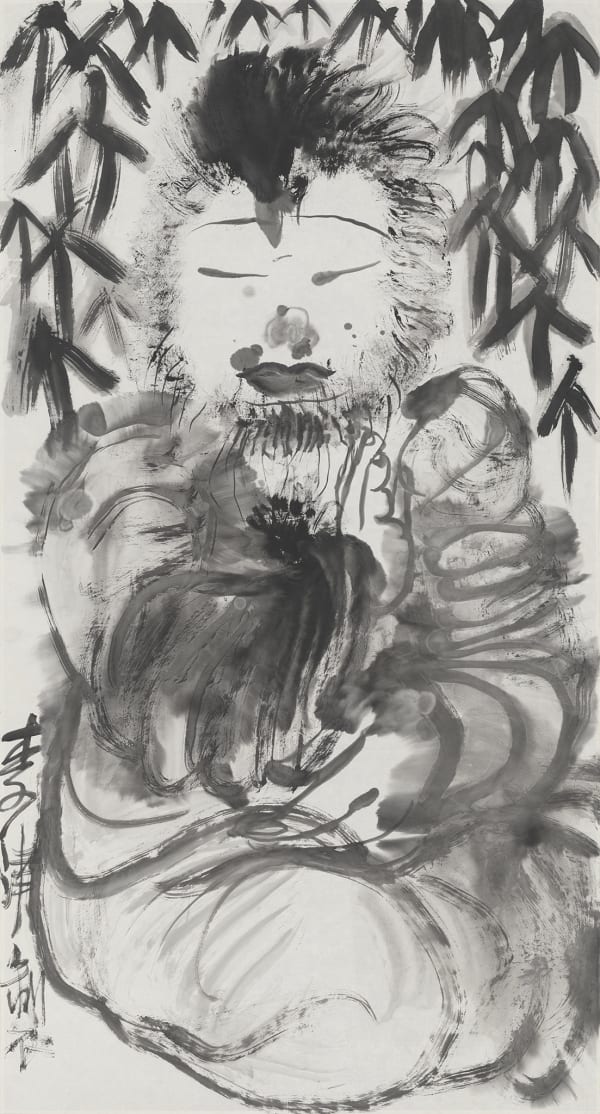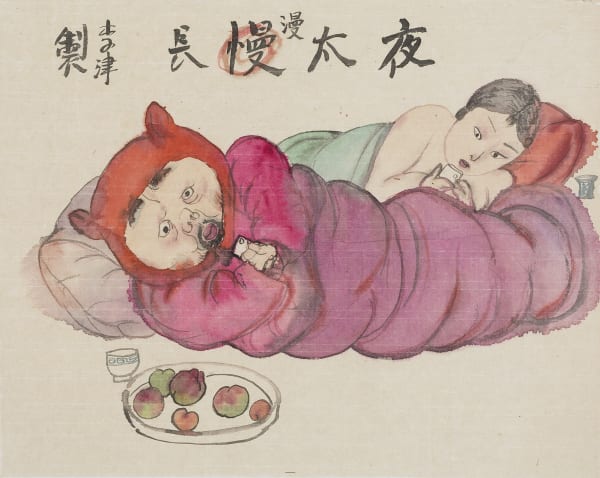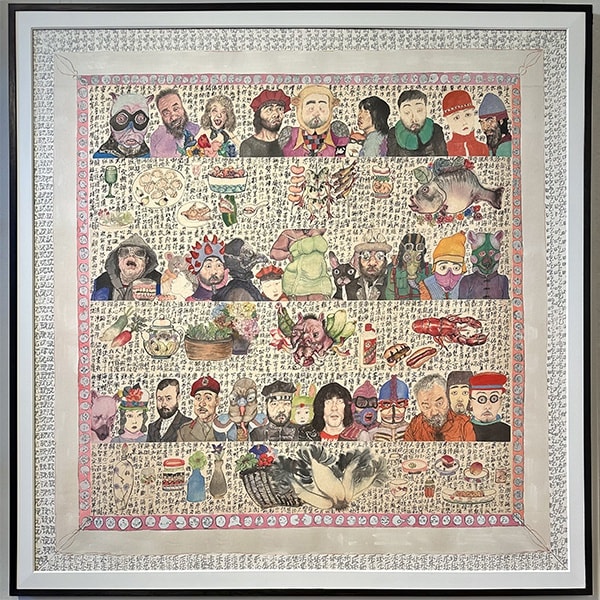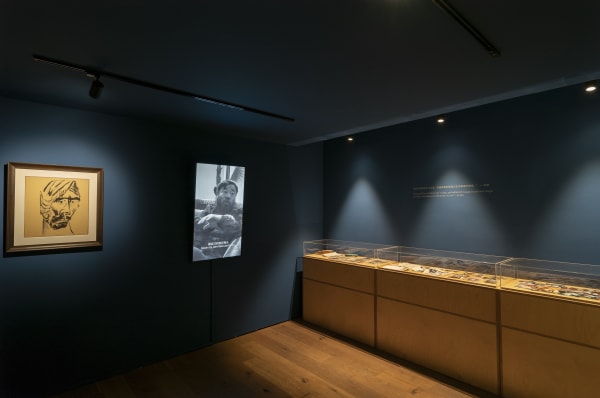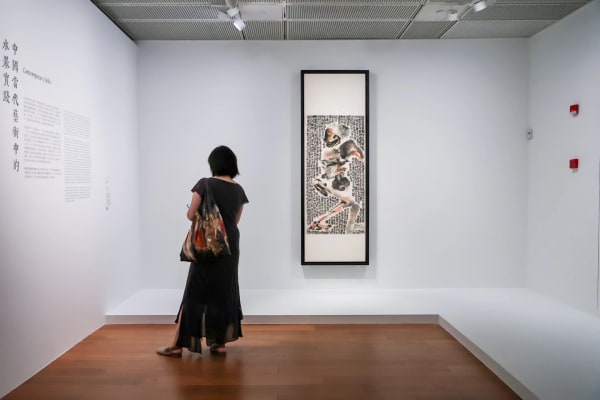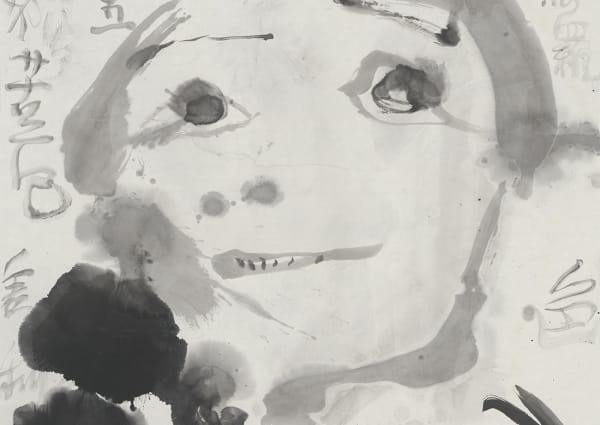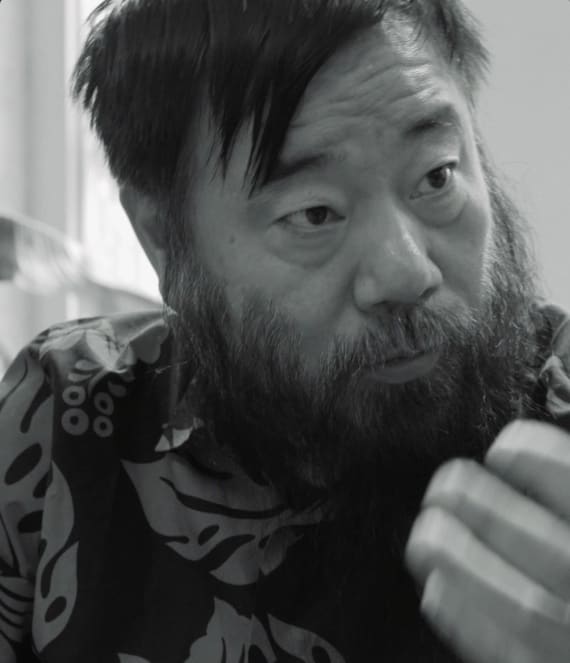Li Jin (b. 1958 in Tianjin, China) is best known for his lush and colorful depictions of sensory pleasures in contemporary China. In his banquet scenes and anecdotal vignettes, voluptuous men and women are surrounded with food in various states of undress and sexual intimacy, but appear awkwardly out of place or spiritually vacant. Often portraits of the artist himself, the figures suggest both playful self-amusement and reflective distance. Indeed, even at their most extravagant, Li Jin's pleasures scenes are tinged with the melancholy of solitude and the unreality of a dream or a memory.
In truth, Li Jin's art has always had a spiritual undertone, perhaps even a spiritual purpose. In 1984, inspired by the examples of van Gogh and Gauguin, he went to Tibet in search for an authentic life and primal connection to nature. There, particularly after witnessing a sky burial, he began to reflect on the limits of corporeal existence. Drawn to the religiosity and the sense of time and history in Tibetan culture, he would sojourn twice again in the region, but would gradually come to recognize its essential alienness from himself.
Upon leaving Tibet in 1993, he set out to embrace the shifting realities of contemporary China under liberalization. Influenced by his encounter with the New Literati painter Zhu Xinjian in Nanjing, and inspired by his new life in a Beijing hutong, he developed an aesthetics of xianhuo, or "aliveness." His paintings came to represent food, sex, and other aspects of quotidian life with honesty and enthusiasm, and in a manner strongly evoking first-hand experience. As he gained in reputation and exposure, his paintings also changed, becoming increasingly boisterous and incorporating experiences of his travels abroad.
The major 2015 retrospective exhibition The Sensory Life of the Mass: 30 Years of Li Jin concluded a phase of his career. Li Jin has now turned his focus towards painting in monochrome, translating his well-honed sensitivity towards color washes into a masterful control of tonality--what is traditionally called the "five colors of ink." He paints in a looser, more gestural and expressive daxieyi style, exploiting the accidental effects of the medium. As if again retreating from the mundane world as he did decades ago in Tibet, Li Jin now seeks to return to a state of freedom and unencumbered creativity.
Li Jin graduated in 1983 from the Chinese Painting Department of the Tianjin Academy of Fine Arts, where he served as Associate Professor until 2018. He was awarded Annual Ink Artist at the 2012 Award of Art China. In 2014, he was selected Artist of the Year by the authoritative publication L'OFFICIEL Art. Li Jin has mounted solo exhibitions in China and in Australia, Germany, and the United States, among other countries. His works are in the collections of major institutions such as the National Art Museum of China; Museum of Fine Arts, Boston; Seattle Art Museum; Hong Kong Museum of Art; Metropolitan Museum of Art; and Ashmolean Museum, Oxford.
-
 Meat #9 红肉9号, 2015
Meat #9 红肉9号, 2015 -
 Vegetable #2 素2号, 2015
Vegetable #2 素2号, 2015 -
 Ink Adept VI 墨道 VI, 2016
Ink Adept VI 墨道 VI, 2016 -
 Ink Adept VII 墨道 VII, 2016
Ink Adept VII 墨道 VII, 2016 -
 Ink Adept II 墨道 II, 2016
Ink Adept II 墨道 II, 2016 -
 Ink Adept I 墨道 I, 2016
Ink Adept I 墨道 I, 2016 -
 The Hand of the Heart 手心, 1992
The Hand of the Heart 手心, 1992 -
 Facing the Wall 面壁, 2015
Facing the Wall 面壁, 2015 -
 Idol 偶像, 2015
Idol 偶像, 2015 -
 Literatus 墨客, 2015
Literatus 墨客, 2015 -
 Seven Sages of the Bamboo Grove 竹林七贤, 2015
Seven Sages of the Bamboo Grove 竹林七贤, 2015 -
 Eating Dumplings on the Winter Solstice 冬至食饺图, 2016
Eating Dumplings on the Winter Solstice 冬至食饺图, 2016 -
 Kissing (in) the Smog 吻霾图 , 2016
Kissing (in) the Smog 吻霾图 , 2016 -
 The Night is Long (and Slow) 夜太漫长, 2016
The Night is Long (and Slow) 夜太漫长, 2016
-

Global INK: INKstudio’s Ten Year Anniversary Exhibition
Bingyi, Chen Haiyan, Huang Chih-yang, Li Jin, Li Huasheng, Liu Dan, Peng Kang-long, Wang Dongling, Wang Tiande, Xu Bing, Yang Jiechang, Zheng Chongbin 17 Jun - 29 Jul 2023The current exhibition, Global INK, is our opportunity to share with everyone what we have discovered over our first decade of programming. It is not a group show but instead a special exhibition consisting of twelve separate solo presentations by twelve artists who we believe define the new global contemporary INK.Read more -

New York | Every One Every Where Every When
Li Jin and the Art of the Portrait 15 - 19 Mar 2023Ukrainian Institute of America 2 E 79th Street New York, NY 10075 Eat, Drink, Man, Woman Li Jin (b. 1958 in Tianjin, China) is perhaps best known for his lush...Read more -

Flesh and Bone
Li Jin 22 Mar - 2 Jun 2019Flesh and Bone uncovers the full story of renowned painter Li Jin’s artistic development during the 1980's and 90's, particularly the impact of his self-exiles in Tibet. This experience transformed his thinking about selfhood and corporeal existence as manifested in his pictorial language and approach to figuration, and lies at the heart of both his colorful pleasure scenes and his freehand monochrome ink paintings.Read more -

Luminous Shadows
18 Nov 2017 - 19 Jan 2018The group exhibition Luminous Shadows explores spirituality and transcendence in the sensory engagement with the material world, recuperating dimensions of art repressed by a modern aesthetics of detached contemplation. The work of art is here ritualized anew as a vehicle for salvation and awakening, a self-conscious theatrical illusion, a sensuous body of pleasure and pain, and an object of pious devotion and yearning.Read more -

Being
Li Jin 28 May - 14 Aug 2016In a new series of boldly expressive monochrome ink paintings, Li Jin departs from his familiar scenes of sensory pleasures and returns to a state of unencumbered creativity.Read more -

INK AND THE BODY
Ink and Phenomenology, Exhibition No. 1 21 Sep - 15 Nov 2014Ink Studio’s premier group show, Ink and the Body , launches a planned series of three exhibitions examining ink painting in terms of the relationship between the subject and both...Read more
-

Exhibition | Li Jin, Wang Tiande, Wei Ligang & Yang Jiechang at "Journey of Ink: Modern and Contemporary Chinese Painting from Musée Cernuschi"
October 9, 2024Journey of Ink: Modern and Contemporary Chinese Painting from Musée Cernuschi 6 Sep 2024 - 5 Jan 2025 Bund One Art Museum, Shanghai The Musée...Read more -

Exhibition | SIMPLE PLEASURES: LI JIN, Ashmolean Museum
May 10, 2024Li Jin with Roger Law: Simple Pleasures 4 May - 17 Nov 2024 Ashmolean Museum This exhibition showcases work by the contemporary Chinese ink master...Read more -

Exhibition | Li Jin at He Art Museum (HEM)
January 4, 2023Meat eaters aren’t superficial – Li Jin’s trip to Shunde 2022.12.31 -2023.03.31 He Art Museum 6 Yixing Rd., Beijiao New Town, Shunde, Guangdong, China He...Read more -

Exhibition | CHINA NOW: NEW LITERATI ART (New York's Asia Week)
March 1, 2017INK studio, the critically-acclaimed Beijing-based art gallery, is pleased to announce China Now: New Literati Art , its inaugural group exhibition in the United States....Read more -

Artist Panel: “Four Takes on the 1980’s”
November 4, 2016Moderators: Craig Yee (INK studio Director), Alan Yeung (INK studio Chief Editor) Participating artists: Li Jin, Wang Dongling, Zheng Chongbin, Zhang Jianjun In the late...Read more -

ART FAIR | INK STUDIO IN SHANGHAI, NOVEMBER 2016
November 3, 2016INK studio is excited to announce its programs in Shanghai in November 2016, at West Bund Art & Design, Art021 Shanghai Contemporary Art Fair, and Shanghai Biennale and featuring the new work of internationally celebrated artists Li Jin, Jennifer Wen Ma, Wang Dongling, and Zheng Chongbin.Read more
-

2023 Gallery Weekend Beijing | Global INK: INKstudio’s Ten Year Anniversary Exhibition
June 30, 2023Read more -

The Enduring Passion for Ink: A Project on Contemporary Ink Painters
Britta Erickson February 7, 2017The Enduring Passion for Ink: A Project on Contemporary Ink Painters (or the 'Project') is a proposed exhibition, book, and film series designed to introduce...Read more -
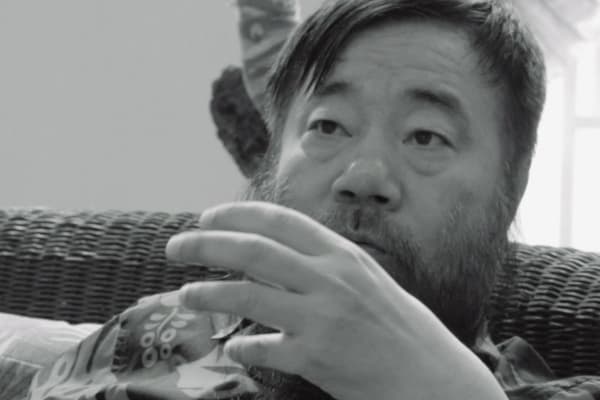
After the Efflorescence: An Interview with Li Jin
June 15, 2016Read more -

Li Jin: Being and Painting
June 15, 2016Read more
